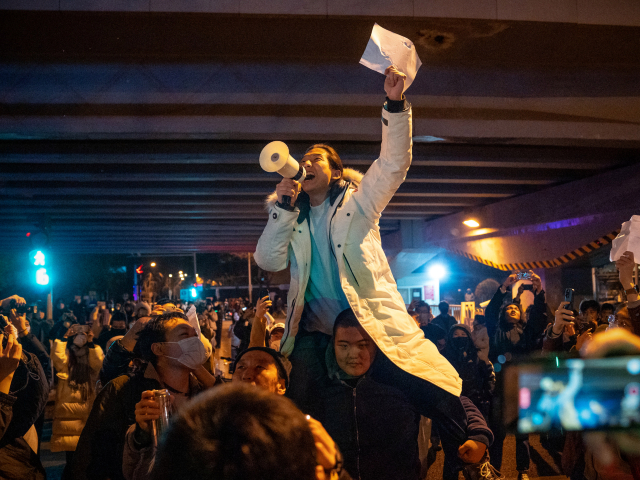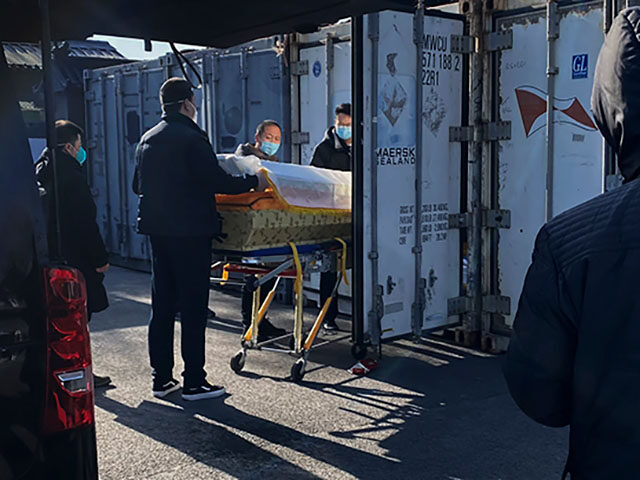The Chinese Ministry of Civil Affairs failed to publish statistics on the number of cremations documented in the last quarter of 2022, the South China Morning Post observed Thursday — the first time in 16 years the agency has not done so.
The end of 2022 marked a particularly chaotic time for China as, following the eruption of protests around the country in late November and years of economic decline triggered by brutal lockdowns, the Communist Party “optimized” its pandemic protocol. Dubbed “zero-Covid,” the official Communist Party policy to address the Wuhan coronavirus pandemic focused heavily on imprisoning thousands of people in quarantine camps and forcing millions in its largest cities into house arrest, fueling needless deaths caused by lack of access to basic medicine and starvation.

A demonstrator holds a blank sign and chants slogans during a protest in Beijing, China, on November 28, 2022. (Bloomberg via Getty Images)
Following the anti-communist protests in November, China’s top coronavirus official, Sun Chunlan, announced the Party would “optimize” its protocol, abruptly ending the lockdowns with no plan to restore order. Chinese communist leaders insisted that the number of coronavirus cases in the country did not increase significantly, but reporting from within the country began compiling evidence of widespread infections and a surge in deaths. Locals in major cities, particularly Beijing, reported hours-long lines to access crematories. Funeral homes were reportedly struggling so much to address demand that many families gave up and burned the bodies of their loved ones at home.
#CHINA: The #COVID outbreak is reportedly forcing people to burn the bodies of their families members on the streets as a result of emergency services and crematoriums' inability to accommodate the mass numbers of deceased. Heartbreaking. pic.twitter.com/Q5TYcG5VJG
— Igor Sushko (@igorsushko) January 3, 2023
The Morning Post noted on Thursday that the national-level Ministry of Civil Affairs published its regular report on general population data on June 9 for the last quarter of 2022 and simply did not include the number of cremations occurring during that time. Multiple governments of Chinese provinces also failed to disclose this figure in their local reports.
“A tally by the Post found that over a dozen provincial-level regions defied their past practices and dropped cremation numbers from public releases,” the newspaper relayed. “Some, including Jiangsu and Zhejiang provinces and the municipalities of Chongqing and Beijing, released their fourth-quarter data largely on time but skipped the cremation service numbers.”
“Others including Hubei, Guangdong and Jiangxi provinces,” it continued, “have not yet released any of their fourth-quarter civil affairs data. Of the provinces included in the Post’s tally, only Yunnan had published any 2023 civil affairs data as of Thursday, and that still did not include cremation numbers – casting doubts on whether information about funeral services would be made public in the future.”
China didn't release data on the number of cremation services held in Q4 2022, obscuring a key indicator of deaths during the Covid-19 wave last winter…https://t.co/bmyVJG7gEx
— Finbarr Bermingham (@fbermingham) June 15, 2023
Chongqing, another province, announced that Beijing had ordered it to stop publishing any civil affairs data indefinitely, the newspaper added.
Workers at funeral homes and crematoria in China anonymous shared anecdotes throughout December of facing a dramatic increase in demand for their services, a sign of growing numbers of people dying following the abrupt end of lockdowns after nearly three years.
“[D]ue to the recent increase in death rates in Beijing, cremations are now being scheduled for 5-7 days’ time. There is a serious issue with the backlog of human remains,” Radio Free Asia (RFA) documented an unnamed Beijing hospital employee as writing on Chinese-controlled social media. RFA also reached out directly to some workers at crematoria, who confirmed a “very busy” season and a struggle to address the growing number of bodies. Adding to the stress, one worker added, were positive coronavirus cases among staffers who could not come into work.
“It doesn’t matter how many furnaces there are; there is a lot of business and we are running them 24 hours, with cremations going on through the night,” one crematorium worker told RFA.
"There is a serious issue with the backlog of human remains."https://t.co/28H8nlL81f
— Radio Free Asia (@RadioFreeAsia) December 15, 2022
Chinese people began turning to do-it-yourself cremations by January. Videos and photos of people burning bodies in parking lots and by the sides of roads began surfacing on Chinese social media, despite the heavy censorship. Beijing reportedly banned families from bringing bodies to funeral homes in their private cars at the time to slow the growing number of such bodies present at the homes.
Despite the evidence of mass death, the Chinese government denied any significant surge in coronavirus deaths following the end of “zero-Covid.” The South China Morning Post noted on Thursday that China documented only 83,150 deaths nationwide between mid-December 2022 and February 2023, in a country claiming a population upwards of 1 billion.
“Recently, the overall pandemic in the country is at a relatively low level,” Sun Chunlan said in mid-January. “The number of critical patients at hospitals is decreasing steadily, though the rescue mission is still heavy.”
RELATED VIDEO — China: Hundreds Protest Communist Censorship by Holding Up Papers Saying… Nothing:
The World Health Organization (W.H.O.), whose leadership spent much of the pandemic praising communist China despite its documented failure to contain the original outbreak of novel coronavirus in Wuhan, questioned the Communist Party’s data in December. Director-General Tedros Adhanom Ghebreyesus urged China to be more forthcoming with real information on the spread of the disease, declaring himself “very concerned over the evolving situation in China with increasing reports of severe disease” that month.
“In order to make a comprehensive risk assessment of the situation on the ground, W.H.O. needs more detailed information on disease severity, hospital admissions, and requirements for ICU support,” he expressed. “W.H.O. is supporting China to focus its efforts on vaccinating people at the highest risk across the country and we continue to offer our support for clinical care and protecting its health system.”

COMMENTS
Please let us know if you're having issues with commenting.